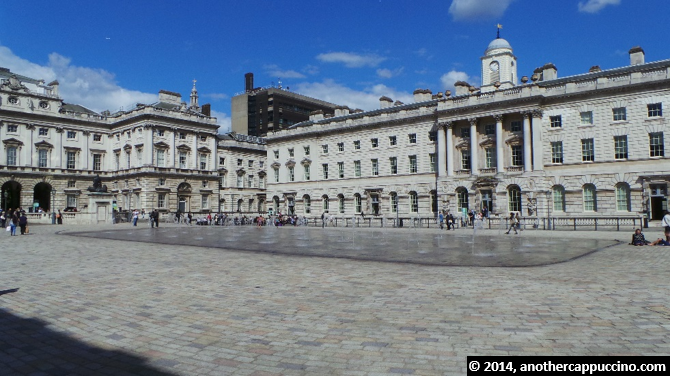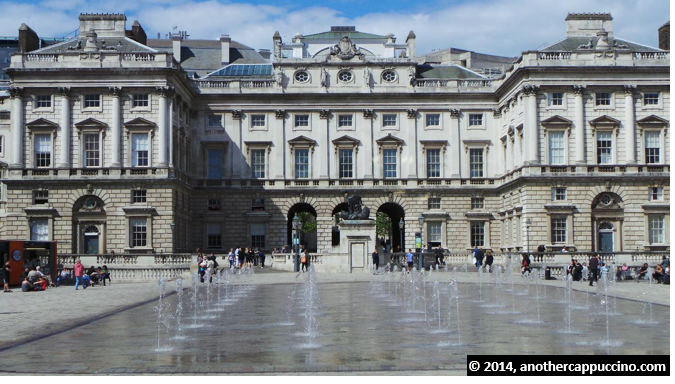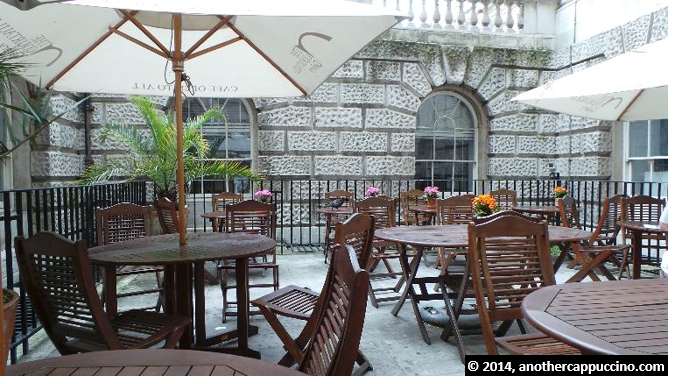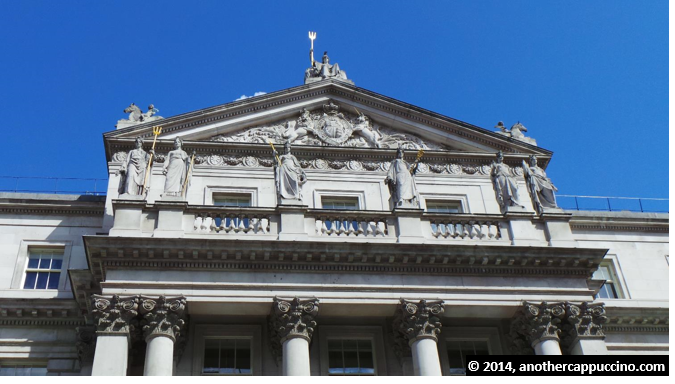
The Courtauld Gallery on the Strand in central London. A view of the main entrance through which visitors pass to reach one of London’s hidden gems in the form of a large square or courtyard complete with 55 fountains.
The Coutauld Gallery is a lot less well-known than some of the major art galleries in London, such as the National Gallery and National Portrait Gallery in Trafalgar Square, Tate Britain on the Thames embankment, near Westminster, and Tate Modern on the south bank of the Thames, across from the main financial district known as the City. This is one reason why I chose to visit the Courtauld Gallery back in August this year. I wanted to enjoy the art and the atmosphere of the location without having to deal with a dense crowd of summer tourists. Not that I have anything against tourists of course. It really is inspiring to see so many visitors to London’s great houses of art, especially those from other countries who have made the effort to travel great distances to the city, but I’m not a “crowd person” and I wanted to have a selfish day when I could relax and saunter at my own leisure without having to compete for viewing space.

A view of the pedestrian-only square in the middle of the Somerset House complex, which includes the Courtauld Gallery. The main feature of the square is a series of 55 fountains, installed in 2000. The building dates from 1775 and was designed in the Palladian (Venetian) style by William Chambers.
This was my first visit to the Courtauld Gallery and what really struck me on entering the grand square in the middle of Somerset House, part of which houses the Courtauld Gallery, was how very European the building looked. Later that morning, after visiting the gallery, I sat at one of the tables by the refreshments stand and enjoyed some coffee while people watching. The large pedestrian cobbled stone square formed by the buildings of Somerset House includes an installation of 55 fountains that children like to play among if their parents let them. I felt as though I was in Brussels or Paris more than in London because of the ambiance produced by the large open space created by the square as well as the fountains. The scene looked more like places I’ve seen in cities on the European content than what is typical for London. (American readers note that many British people – especially people in their 40s and older – think of Britain as being separate from the rest of Europe. Hence the distinction between London and cities “on the continent.”)

The back of the Courtauld Gallery seen from the square. The cafe is located below ground in the left-hand corner of the building.
The Courtauld Gallery is located on the Strand in central London, a road that is probably most famous today for the Inns of Court and the Royal Courts of Justice, which are located where the Strand meets Fleet Street, once the home of journalism in London. It’s a historic area of London and was once one of the most fashionable streets in London. The Twinings teashop at No. 216 was opened by Thomas Twining in 1706 is also worth a visit. I reached the gallery from my hotel by taking a District line tube to Temple on the Thames embankment. I entered Somerset House from the Victoria Embankment entrance, although I later discovered that the main entrance to the Courtauld Gallery is on the Strand, where one passes through a Palladian archway, inspired by architecture found in Venice.

The cafe patio at the Courtauld Gallery. I enjoyed a very good cappuccino here while scribbling some notes about my visit. The waiter service was also excellent.
The Courtauld Gallery is not large compared to the institutions mentioned above. It took me about three hours to walk through all the rooms in the gallery, and I moved at a very leisurely pace. Luckily, I visited the gallery on a Friday, which I discovered is one of the two days each week, the other being Monday, when a member of staff gives a free lunchtime lecture on selected artworks in the gallery. On the day I visited, an American curator gave a talk on one of the Venetian pieces, which was a pair of large wooden wedding chests (cassoni) from the fifteenth century that would have been carried through the streets of Venice, containing the bride’s dowry and wedding gifts. Known as the Morelli-Nerli wedding chests, they would have been carried to the bride’s new home as one of the wedding ceremonies. The chests are decorated with paintings depicting scenes from ancient Rome by Jacopo del Sellaio and Biagio d’Antonio, designed to depict lessons or wisdom considered to be helpful for the newly married couple. The carvings and paintings, not to mention the size, that make up these chests made them appear extremely impressive. According to the curator, these chests are unique because of their completeness.
The Courtauld Gallery focuses on European art, from the medieval and Renaissance periods (13th-16th centuries) through to 19th century French Impressionism and post-Impressionism, and then to 20th century French, German and British art. The gallery also puts on special temporary exhibits. The first floor houses numerous examples of French Impressionist art, including by Monet, one of my personal favorites.

Claude Monet’s Vase of Flowers, begun 1881-2 and, after setting it aside for many years, completed about 40 years later! This paining is from Monet’s early period when he painted mostly still-lifes. On display on the first floor of the Courtauld Gallery.
The art is displayed on three floors, while the lower ground floor is used for a café, which includes a patio. It was a beautiful sunny day with a mostly clear blue sky when I visited the gallery. Just outside the café, close to the bathrooms, there are some lockers that can be used for free as far as I remember. I had a small backpack, which I did not want to carry around with me, so I left it in a locker. A nice convenience feature provided by the gallery. I stopped in the café early in the morning. I made it my first stop after arriving at the gallery, which was good because the café was almost empty. I sat out on the patio, which is below street level and surrounded on all sides by the building walls. Most of the patio tables have large umbrella shades, which must be great for hot summer days when the sun is beating down. On the ground floor, across from the main entrance to the gallery, there is a separate entrance for the gallery shop, which contains quality gift items, books postcards, and other items typically found in gallery shops.
I was really impressed with the Courtauld Institute and thoroughly enjoyed my visit. The building is beautiful and the collection covers a wide range of historical periods and art movements. It is easy to find and just a short walk from the nearest tube station at Temple. The gallery is open daily from 10 a.m. to 6 p.m., with last admission at 5:30 p.m. More information is available on the gallery’s website. Below, I’ve selected two pieces that I thought were particularly beautiful.



No comments yet.